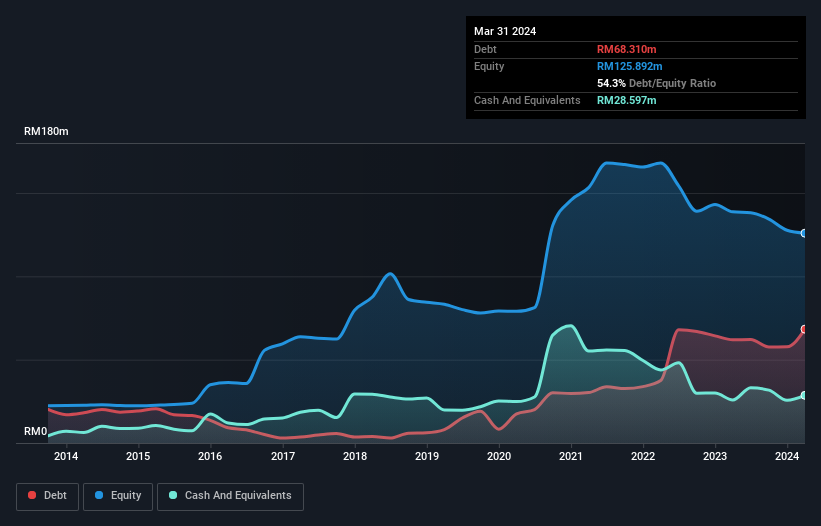Here's Why Asia Poly Holdings Berhad (KLSE:ASIAPLY) Can Afford Some Debt

Howard Marks put it nicely when he said that, rather than worrying about share price volatility, 'The possibility of permanent loss is the risk I worry about... and every practical investor I know worries about.' When we think about how risky a company is, we always like to look at its use of debt, since debt overload can lead to ruin. We note that Asia Poly Holdings Berhad (KLSE:ASIAPLY) does have debt on its balance sheet. But should shareholders be worried about its use of debt?
When Is Debt A Problem?
Debt assists a business until the business has trouble paying it off, either with new capital or with free cash flow. If things get really bad, the lenders can take control of the business. However, a more usual (but still expensive) situation is where a company must dilute shareholders at a cheap share price simply to get debt under control. Of course, the upside of debt is that it often represents cheap capital, especially when it replaces dilution in a company with the ability to reinvest at high rates of return. When we think about a company's use of debt, we first look at cash and debt together.
View our latest analysis for Asia Poly Holdings Berhad
What Is Asia Poly Holdings Berhad's Net Debt?
The image below, which you can click on for greater detail, shows that at March 2024 Asia Poly Holdings Berhad had debt of RM68.3m, up from RM61.9m in one year. However, because it has a cash reserve of RM28.6m, its net debt is less, at about RM39.7m.

How Healthy Is Asia Poly Holdings Berhad's Balance Sheet?
We can see from the most recent balance sheet that Asia Poly Holdings Berhad had liabilities of RM61.2m falling due within a year, and liabilities of RM31.7m due beyond that. Offsetting these obligations, it had cash of RM28.6m as well as receivables valued at RM23.6m due within 12 months. So its liabilities total RM40.7m more than the combination of its cash and short-term receivables.
This deficit isn't so bad because Asia Poly Holdings Berhad is worth RM71.9m, and thus could probably raise enough capital to shore up its balance sheet, if the need arose. But we definitely want to keep our eyes open to indications that its debt is bringing too much risk. When analysing debt levels, the balance sheet is the obvious place to start. But it is Asia Poly Holdings Berhad's earnings that will influence how the balance sheet holds up in the future. So when considering debt, it's definitely worth looking at the earnings trend. Click here for an interactive snapshot.
In the last year Asia Poly Holdings Berhad wasn't profitable at an EBIT level, but managed to grow its revenue by 17%, to RM115m. We usually like to see faster growth from unprofitable companies, but each to their own.
Caveat Emptor
Over the last twelve months Asia Poly Holdings Berhad produced an earnings before interest and tax (EBIT) loss. To be specific the EBIT loss came in at RM6.0m. When we look at that and recall the liabilities on its balance sheet, relative to cash, it seems unwise to us for the company to have any debt. So we think its balance sheet is a little strained, though not beyond repair. Another cause for caution is that is bled RM12m in negative free cash flow over the last twelve months. So in short it's a really risky stock. When analysing debt levels, the balance sheet is the obvious place to start. But ultimately, every company can contain risks that exist outside of the balance sheet. Case in point: We've spotted 3 warning signs for Asia Poly Holdings Berhad you should be aware of, and 2 of them don't sit too well with us.
If you're interested in investing in businesses that can grow profits without the burden of debt, then check out this free list of growing businesses that have net cash on the balance sheet.
New: Manage All Your Stock Portfolios in One Place
We've created the ultimate portfolio companion for stock investors, and it's free.
• Connect an unlimited number of Portfolios and see your total in one currency
• Be alerted to new Warning Signs or Risks via email or mobile
• Track the Fair Value of your stocks
Have feedback on this article? Concerned about the content? Get in touch with us directly. Alternatively, email editorial-team (at) simplywallst.com.
This article by Simply Wall St is general in nature. We provide commentary based on historical data and analyst forecasts only using an unbiased methodology and our articles are not intended to be financial advice. It does not constitute a recommendation to buy or sell any stock, and does not take account of your objectives, or your financial situation. We aim to bring you long-term focused analysis driven by fundamental data. Note that our analysis may not factor in the latest price-sensitive company announcements or qualitative material. Simply Wall St has no position in any stocks mentioned.
Have feedback on this article? Concerned about the content? Get in touch with us directly. Alternatively, email editorial-team@simplywallst.com
About KLSE:ASIAPLY
Asia Poly Holdings Berhad
An investment holding company, manufactures and sells cell cast acrylic sheets.
Slight with mediocre balance sheet.
Market Insights
Community Narratives




